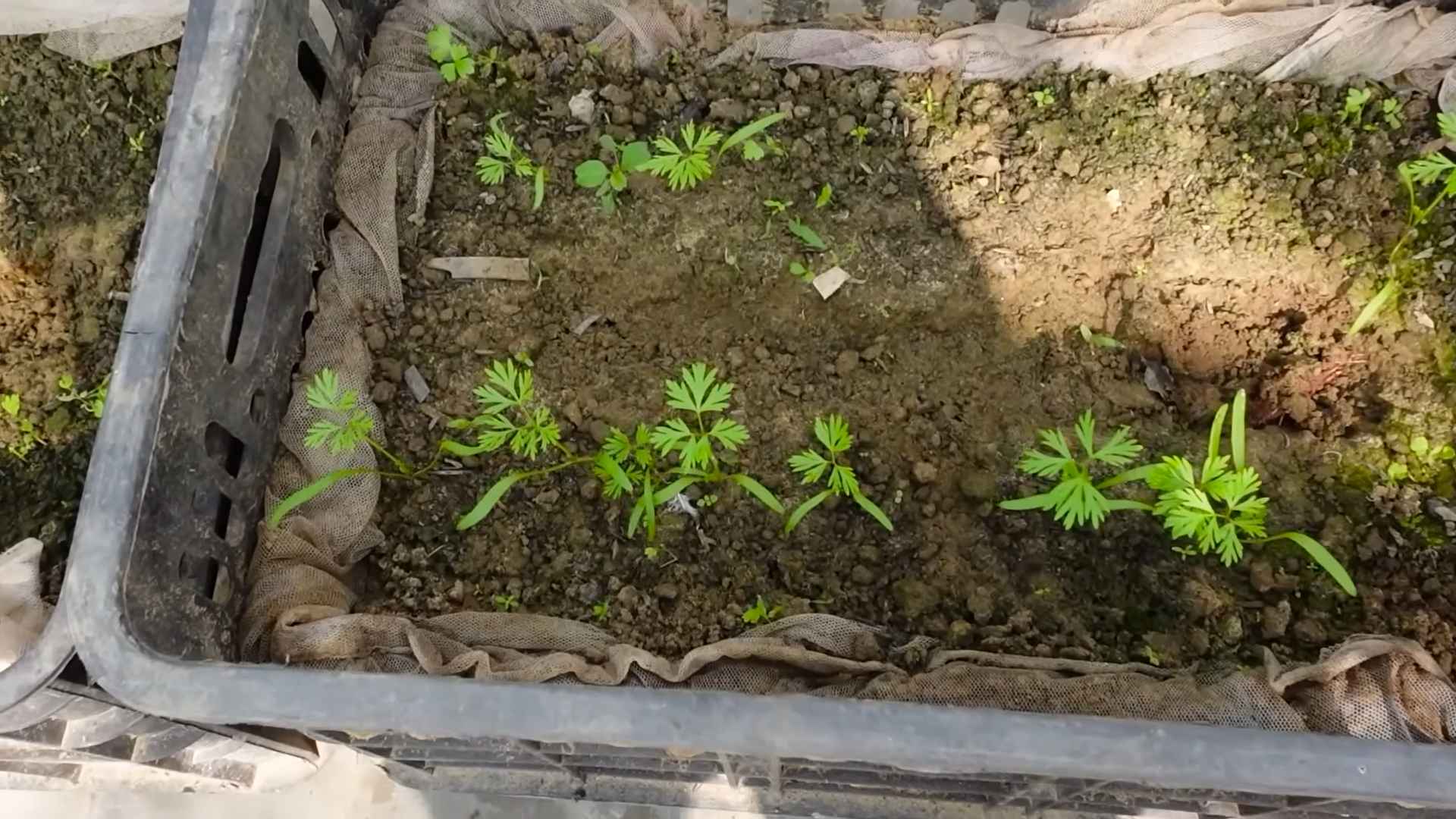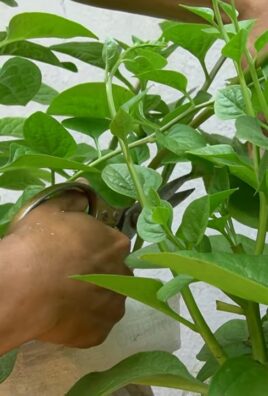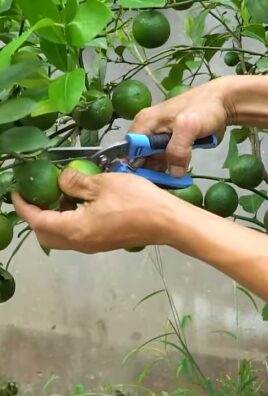Grow Carrots at Home? Absolutely! Imagine plucking vibrant, sweet carrots straight from your own backyard – fresher than anything you’ll find at the grocery store. Sounds dreamy, right? Well, it’s totally achievable, even if you’re a beginner gardener like I once was!
For centuries, carrots have been a staple in diets worldwide, with their cultivation dating back to ancient times. Originally, they weren’t even orange! These root vegetables were purple, white, and yellow before Dutch growers in the 17th century popularized the orange variety we know and love today. Now, you can continue this rich history by growing your own.
But why bother with the effort? Because let’s face it, store-bought carrots often lack that intense, earthy flavor. Plus, knowing exactly where your food comes from and how it’s grown is incredibly rewarding. And that’s where this DIY guide comes in. I’m going to share some simple yet effective tricks and hacks that will help you grow carrots at home successfully, regardless of your space or experience. From choosing the right soil to preventing common pests, I’ve got you covered. Get ready to enjoy the satisfaction of harvesting your own delicious, homegrown carrots!

Growing Carrots at Home: A Beginner’s Guide
Hey there, fellow gardening enthusiasts! Ever dreamt of pulling fresh, crunchy carrots straight from your own backyard? Well, dream no more! Growing carrots at home is surprisingly easy and rewarding, even if you’re a complete beginner. I’m going to walk you through every step, from choosing the right variety to harvesting your delicious bounty. Let’s get our hands dirty!
Choosing the Right Carrot Variety
Before we even think about planting, we need to pick the perfect carrot for our garden. There are tons of different varieties, each with its own unique characteristics. Here’s a quick rundown to help you decide:
* Nantes: These are classic, cylindrical carrots with a sweet flavor and smooth skin. They’re a great all-around choice and mature relatively quickly.
* Danvers: These are longer and more tapered than Nantes carrots, with a slightly stronger flavor. They’re also known for their good storage qualities.
* Chantenay: These are short, stubby carrots that are perfect for heavy or rocky soils. They have a sweet flavor and are great for juicing.
* Imperator: These are the long, slender carrots you often see in supermarkets. They require loose, well-drained soil to grow properly.
* Round Carrots (Parisian): These are small, round carrots that are perfect for containers or small gardens. They mature quickly and have a mild flavor.
Consider your soil type, growing space, and personal preferences when making your choice. I personally love Nantes carrots because they’re easy to grow and taste fantastic!
Preparing the Soil: The Key to Success
Carrots need loose, well-drained soil to grow long and straight. Rocky or compacted soil will result in stunted, misshapen carrots. This is probably the most important step, so don’t skip it!
* Soil Testing: Before you do anything, it’s a good idea to test your soil’s pH. Carrots prefer a slightly acidic soil with a pH between 6.0 and 6.8. You can buy a soil testing kit at most garden centers.
* Loosening the Soil: Use a garden fork or tiller to loosen the soil to a depth of at least 12 inches. Remove any rocks, stones, or debris that could impede root growth.
* Adding Organic Matter: Incorporate plenty of compost or well-rotted manure into the soil. This will improve drainage, add nutrients, and help retain moisture.
* Creating Raised Beds (Optional): If you have heavy clay soil, consider creating raised beds. This will improve drainage and allow the soil to warm up faster in the spring.
* Avoid Fresh Manure: Don’t use fresh manure, as it can cause forked roots.
Planting Carrot Seeds: Getting Started
Now that our soil is prepped, it’s time to plant those tiny carrot seeds!
1. Timing is Everything: Carrots are a cool-season crop, so plant them in early spring or late summer for a fall harvest. Check your local frost dates to determine the best planting time for your area. I usually aim to plant about 2-3 weeks before the last expected frost in spring.
2. Creating Furrows: Use a hoe or trowel to create shallow furrows in the soil, about 1/4 to 1/2 inch deep and 1-2 inches apart.
3. Sowing the Seeds: Carrot seeds are tiny, so it’s easy to sow them too thickly. Try to space the seeds about 1/2 inch apart in the furrows. You can use a seed dispenser or simply pinch the seeds between your fingers.
4. Covering the Seeds: Gently cover the seeds with a thin layer of soil.
5. Watering: Water the soil thoroughly but gently, using a watering can or hose with a gentle spray nozzle. Keep the soil consistently moist until the seeds germinate.
6. Marking the Rows: Label your rows with the carrot variety and planting date. This will help you keep track of your progress.
Caring for Your Carrot Plants: Nurturing Growth
Once your carrot seeds have germinated, it’s important to provide them with the care they need to thrive.
* Thinning: This is crucial! When the seedlings are about 2 inches tall, thin them to about 1-2 inches apart. This will give the remaining plants enough space to develop properly. You can use small scissors to snip off the unwanted seedlings at the soil line. Don’t pull them out, as this can disturb the roots of the remaining plants. Thin again when they are about 4 inches tall to 3-4 inches apart.
* Watering: Carrots need consistent moisture to grow well. Water deeply and regularly, especially during dry spells. Aim for about 1 inch of water per week.
* Weeding: Keep the area around your carrot plants free of weeds. Weeds compete with carrots for water and nutrients. Hand-pull weeds carefully to avoid disturbing the carrot roots.
* Fertilizing: Carrots are not heavy feeders, but they will benefit from a light feeding of fertilizer. Use a balanced fertilizer or a fertilizer specifically formulated for root vegetables. Follow the instructions on the fertilizer package. I like to use a liquid seaweed fertilizer diluted in water every few weeks.
* Mulching: Apply a layer of mulch around your carrot plants to help retain moisture, suppress weeds, and regulate soil temperature. Straw, hay, or shredded leaves are all good options.
Dealing with Pests and Diseases
While carrots are relatively easy to grow, they can be susceptible to certain pests and diseases. Here are a few common problems and how to deal with them:
* Carrot Rust Fly: This is a common pest that lays its eggs near the base of carrot plants. The larvae burrow into the roots, causing damage and making them unmarketable. To prevent carrot rust fly, cover your plants with row covers. You can also use nematodes to control the larvae in the soil.
* Nematodes: These microscopic worms can damage carrot roots, causing them to become stunted and misshapen. To control nematodes, rotate your crops regularly and incorporate organic matter into the soil.
* Leaf Spot: This fungal disease causes brown spots to appear on the leaves. To prevent leaf spot, provide good air circulation and avoid overhead watering.
* Aster Yellows: This disease is spread by leafhoppers and causes the leaves to turn yellow and the roots to become hairy. To prevent aster yellows, control leafhoppers and remove any infected plants.
Harvesting Your Carrots: The Grand Finale
The moment we’ve all been waiting for! Harvesting your own homegrown carrots is incredibly satisfying.
1. When to Harvest: Carrots are typically ready to harvest 60-80 days after planting, depending on the variety. Check the seed packet for specific maturity dates. You can also gauge ripeness by looking at the size of the carrot tops.
2. Loosening the Soil: Before pulling your carrots, loosen the soil around them with a garden fork. This will make them easier to pull and prevent them from breaking.
3. Pulling the Carrots: Grasp the carrot tops firmly and gently pull the carrots straight up out of the ground. If they’re difficult to pull, use the garden fork to loosen the soil further.
4. Cleaning the Carrots: Brush off any excess soil from the carrots.
5. Storing the Carrots: Cut off the green tops, leaving about 1/2 inch of stem. Store the carrots in a cool, dark, and humid place, such as a refrigerator or root cellar. You can also store them in a container filled with moist sand or sawdust.
Enjoying Your Harvest: From Garden to Table
Now that you’ve harvested your delicious carrots, it’s time to enjoy them! Carrots can be eaten raw, cooked, or juiced. They’re a versatile vegetable that can be used in a variety of dishes.
* Raw: Enjoy them as a snack with hummus, add them to salads, or grate them into coleslaw.
* Cooked: Roast them with other vegetables, steam them, or add them to soups and stews.
* Juiced: Carrot juice is a healthy and refreshing drink.
Growing carrots at home is a rewarding experience that anyone can enjoy. With a little bit of planning and effort, you can have a bountiful harvest of fresh, delicious carrots right from your own backyard. Happy gardening!

Conclusion
So, there you have it! Growing carrots at home, while it might seem daunting at first, is incredibly rewarding and surprisingly simple with the right approach. We’ve walked you through the essential steps, from seed selection to harvesting, and hopefully, demystified the process along the way. But why should you bother? Why dedicate precious garden space (or even a container on your balcony) to cultivating these vibrant root vegetables?
The answer is multifaceted. Firstly, the taste of homegrown carrots is simply unparalleled. Forget the bland, sometimes bitter, supermarket varieties. Homegrown carrots, especially when harvested at their peak ripeness, offer a sweetness and crispness that will redefine your perception of this humble vegetable. Imagine biting into a carrot still warm from the sun, its flavor bursting with earthy goodness. That’s the magic of growing your own.
Secondly, you have complete control over the growing process. No need to worry about harmful pesticides or herbicides. You can choose organic methods, ensuring that your carrots are not only delicious but also healthy and safe for you and your family. This peace of mind is invaluable in today’s world.
Thirdly, growing carrots at home is a fantastic learning experience. It connects you to nature, teaches you about the cycles of life, and provides a sense of accomplishment that’s hard to replicate. It’s a therapeutic activity that can reduce stress and improve your overall well-being. Plus, it’s a great way to get kids involved in gardening and teach them about where their food comes from.
And finally, let’s talk about the sheer variety you can explore. Forget the standard orange Nantes carrot. You can experiment with purple, yellow, white, and even red varieties. You can grow baby carrots for snacking or larger varieties for juicing and cooking. The possibilities are endless!
Consider these variations to personalize your carrot-growing experience:
* Container Gardening: If you’re short on space, container gardening is an excellent option. Choose a deep container (at least 12 inches) and use a well-draining potting mix. Dwarf or baby carrot varieties are particularly well-suited for containers.
* Succession Planting: Plant a new batch of carrot seeds every few weeks to ensure a continuous harvest throughout the growing season.
* Companion Planting: Plant carrots alongside onions, garlic, or rosemary to deter pests.
* Different Varieties: Experiment with different carrot varieties to find your favorites. Nantes, Chantenay, and Imperator are all popular choices.
* Raised Beds: Raised beds offer excellent drainage and soil control, making them ideal for growing carrots.
We truly believe that growing carrots at home is a must-try for any gardener, regardless of experience level. It’s a rewarding, delicious, and educational experience that will enrich your life in countless ways. So, grab some seeds, prepare your soil, and get ready to enjoy the fruits (or rather, vegetables) of your labor.
We’re confident that you’ll be amazed by the results. And we can’t wait to hear about your experiences! Share your photos, tips, and stories with us in the comments below. Let’s build a community of home carrot growers and inspire others to embrace the joy of gardening. Happy growing!
Frequently Asked Questions (FAQ)
What is the best time of year to plant carrots?
The best time to plant carrots depends on your climate. In general, carrots are a cool-season crop and thrive in temperatures between 60°F and 70°F (15°C and 21°C). For most regions, this means planting in early spring or late summer/early fall. Spring plantings should occur as soon as the soil can be worked, typically a few weeks before the last expected frost. Fall plantings should be timed so that the carrots have enough time to mature before the first hard frost. Check your local extension office for specific planting dates in your area.
What kind of soil do carrots need?
Carrots need loose, well-drained soil that is free of rocks and debris. Rocky or compacted soil can cause the carrots to become stunted, forked, or misshapen. The ideal soil pH for carrots is between 6.0 and 6.8. Amend heavy clay soils with compost, sand, or other organic matter to improve drainage and aeration. Avoid using fresh manure, as it can cause the carrots to become hairy.
How deep should I plant carrot seeds?
Carrot seeds are very small and should be planted shallowly. Sow the seeds about ¼ to ½ inch deep and space them about 1-2 inches apart in rows that are 12-18 inches apart. Gently cover the seeds with soil and water thoroughly. Keep the soil consistently moist until the seeds germinate, which usually takes 7-21 days.
How often should I water carrots?
Carrots need consistent moisture to thrive. Water deeply and regularly, especially during dry periods. Aim to keep the soil consistently moist but not waterlogged. Overwatering can lead to root rot, while underwatering can cause the carrots to become tough and bitter. A good rule of thumb is to water when the top inch of soil feels dry to the touch.
How do I thin carrot seedlings?
Thinning is essential for ensuring that carrots have enough space to develop properly. Once the seedlings are a few inches tall, thin them to about 2-3 inches apart. Gently pull out the excess seedlings, being careful not to disturb the roots of the remaining plants. You can eat the thinned seedlings as microgreens.
What are some common carrot pests and diseases?
Common carrot pests include carrot rust flies, aphids, and nematodes. Carrot rust flies lay their eggs near the base of the plants, and the larvae burrow into the roots, causing damage. Aphids suck the sap from the leaves, weakening the plants. Nematodes are microscopic worms that can damage the roots. Common carrot diseases include leaf blight and root rot. Practice crop rotation, use disease-resistant varieties, and maintain good soil drainage to prevent these problems.
How do I know when carrots are ready to harvest?
Carrots are typically ready to harvest 60-80 days after planting, depending on the variety. Check the seed packet for specific maturity dates. You can harvest carrots when they reach the desired size. Gently loosen the soil around the carrots and pull them up by the tops. If the soil is dry, water it thoroughly before harvesting to make it easier to pull the carrots.
Can I store carrots after harvesting?
Yes, carrots can be stored for several months if properly stored. Remove the tops, brush off any excess soil, and store the carrots in a cool, dark, and humid place, such as a refrigerator or root cellar. You can also store carrots in a container filled with moist sand or sawdust.
What are some good companion plants for carrots?
Good companion plants for carrots include onions, garlic, rosemary, sage, and marigolds. Onions and garlic deter carrot rust flies, while rosemary and sage repel other pests. Marigolds attract beneficial insects that prey on carrot pests. Avoid planting carrots near dill or fennel, as they can inhibit carrot growth.
Can I grow carrots in containers?
Yes, carrots can be grown in containers, but you’ll need to choose a deep container (at least 12 inches) and use a well-draining potting mix. Dwarf or baby carrot varieties are particularly well-suited for containers. Make sure the container receives at least 6 hours of sunlight per day.
What are the benefits of growing carrots at home?
Growing carrots at home offers several benefits, including fresher, more flavorful carrots, control over the growing process (allowing you to avoid pesticides and herbicides), a rewarding gardening experience, and the opportunity to experiment with different varieties. Plus, homegrown carrots are often more nutritious than store-bought carrots.





Leave a Comment